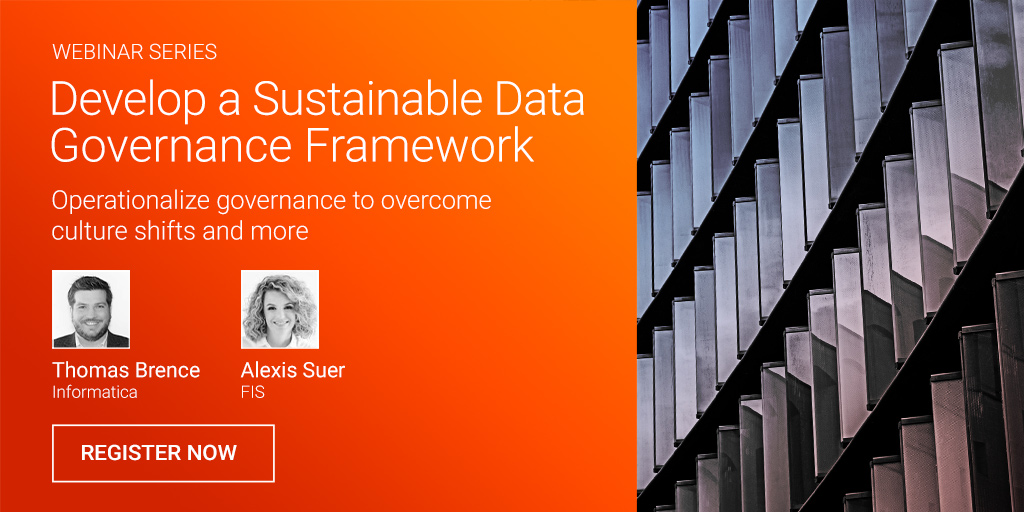The Evolution of Data Governance at FIS
If you take a moment and research culture change, you’ll find a myriad of different articles on how to best navigate new hurdles and overcome challenges to be successful. But this is important research to do whenever you’re launching a new, enterprise-wide data governance program. As a governance leader, you are always going to be faced with the uphill battle of those who refuse to see governance as anything but compliance and red tape, instead of a team that can drive real organizational value. Compound this challenge to organizational culture with multiple mergers and acquisitions and—to borrow an analogy from one of our customers—it’s like climbing a mountain, and getting through the fog, before realizing that you’ve only made it half the way to your goal. This was the case for the enterprise data governance team at FIS.

On February 26, 2020, we’ll present the next episode of our Data Empowerment Experts series, which features FIS, a global technology and service leader that helps businesses and communities thrive by advancing commerce and the financial world. “Keeping Up with the Chaos: The Evolution of Data Governance at FIS” deals with this very issue of culture change. Whether your organization is going through a merger or you’re simply trying to launch a centralized program for enterprise data governance, this informative and education webinar will share best practices that can position you for success, especially when you’re managing culture change.
This month’s Data Empowerment Expert, Alexis Suer, the Leader for Global Big Data Governance at FIS, recently sat down with me to discuss her journey as a preview for her upcoming webinar:
Question: How do you choose where to start?
Answer: We were fortunate that the inception of our Data Governance Team was centered around (and funded by) a large-scale Finance Data transformation project focused on managerial reporting. That initiative was centered around the build of a data mart which would become the single source of truth. Due to the rapid growth of our organization via several large-scale mergers and acquisitions during 2013-2019, we had a disparate data environment, which made even the simple tasks very difficult for finance business users. Having a specific use case allowed us to not only home in on where to begin but ensured that we were deliberately driving business value. However, we certainly had our fair share of false starts and lessons learned within the project itself! For instance, we thought that every data element that we profiled using Informatica Data Quality needed a data quality rule if the histogram deemed it necessary. But the key questions we didn’t ask were: Who is going to monitor and maintain all these rules? Does the business care? Does this drive value? This is where Data Stewardship became a critical factor.
Question: How do you maintain momentum?
Answer: We are always looking for our next use case! I like to compare Data Governance to a mountain, we certainly aren’t going to move it. But what we can do is build it, use case by use case. Think of each use case as a stone or maybe even a bigger boulder, like our Finance Data Program. They begin to pile up and interconnect and before you know it, you have quite an impressive monument. Informatica’s Axon Data Governance tool is the secret weapon for getting business user buy-in and selling our services for our next use case. The user interface of the data governance tool allows our team to demonstrate work through relatable business terms and systems titles that are recognizable to the business. As an example, we have standards in place that ensure we name assets within System and Data Set facets based on what users would search for, such as Finance Data Mart instead of a technical schema name. When we show this information accompanied by the lineage functionality within the tool, it’s impressive. It solves a critical need that is missing for so many data users within our organization. Nevertheless, we haven’t run out of work to do—or use cases to tackle—as word about our work has spread through the organization.
Question: How do you address scale?
Answer: Have I told you about my mountain analogy? But seriously, it truly is about not only starting with business use cases: it’s also about implementing data governance capabilities that scale. Our team has a Minimum Viable Product (MVP) checklist for every new data project. This allows us to ensure that we can implement the foundations quickly and repeatably. Those MVP checklist items ensure that we are compliant with FIS Policy, and provide value to our business stakeholders by providing data lineage and critical data quality checks up front. From there, we show in phases what the next iterations look like, always ensuring we are driving business value through our stewardship model. Our Informatica technologies help to serve this quite well since Informatica Data Quality, Axon Data Governance, and the Enterprise Data Catalog all interface to create a streamlined technical approach that supports our processes.
Question: How do you measure success?
Answer: This is always a tricky one for Data Governance teams and continues to be something that I often ponder over my morning coffee. How do we continue to show the hard work and value that we bring to the organization in the most impactful way? What speaks the most to our stakeholders? It always comes back to the almighty dollar. Money talks, especially to executives, and rightfully so. For example, we can quantify people hours lost due to data incident remediation. If we save time in the data cleansing stage by bringing attention to and working with the appropriate data owners to ensure that high priority data incidents are tackled, we report that as money saved. Our next KPI we are working on is to identify redundancies within our data lakes by using the scanning capabilities of the Enterprise Data Catalog. By sunsetting redundant data sets, we can quantify and monetize savings related to computing, data storage, processing, and more.
Question: How has data privacy been a factor?
Answer: We have certainly seen a shift in our focus over the last 18 months to data protection within our governance organization. Earlier, during the Finance Data Project, we focused primarily on data quality and ensuring trusted data. But now, trusted data refers not just to quality data but to safe data. It is our team’s responsibility, now more than ever, to ensure that our Data Technology teams are handling, storing, and using data according to our FIS policy which tells our organization how to ensure we are compliant with regulations. We also must ensure our Data Technology teams are prepared to respond to Data Subject Access Requests (DSARs) which are included in both GDPR and CCPA. In order to set our organization up for success in this new Data Privacy landscape, we have introduced a new role within our Data Governance team. The Data Governance Relationship Manager role is responsible for acting as the primary liaison between our Data Protection teams (Privacy, Legal, Security, and Risk) and Data Technology. The individuals in this role are athletic communicators who understand policy and data development. We rely on our Relationship Managers for guidance on what we need to do to remain compliant, keep up to date on relevant data protection regulations, and provide education to technology teams on the processes we must follow and why they are important.
Question: How do you empower the business to drive value?
Answer: We have set up our Data Governance organization in a way that allows us to be nimble and flex to the priorities of the organization. By using tools such as Enterprise Data Catalog, Informatica Data Quality, and Axon Data Governance, we are able to connect to new metadata sources in a very methodical manner. This is important for the MVP model that we have built, as we are very quickly able to add value for new data projects, changing technologies (such as cloud), and organizational change.
I hope that you’ll join Alexis and I on February 26th where we’ll dive even deeper into the data governance journey at FIS. We’ll talk about best practices, how to get started, developing a solid starting foundation, and how to build momentum, even when you’re tasked with moving mountains.









